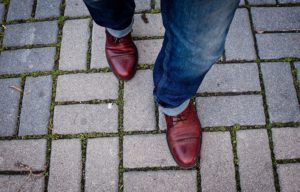G’day mates! How ya goin’?

I recently returned from a once-in-a-lifetime, 3-week trip to Australia. I traveled across the world to 1) share the preliminary results of a study that Dr. Karen S. Whelan-Berry and I are co-leading and 2) enjoy the culture and hospitality of our Aussie friends Down Under. I’ll share more about the study in a future blog post.
Surprisingly, I noticed a slight language barrier even though everyone spoke English. I was unfamiliar with certain pronunciations and colloquialisms, which impeded my ability to understand and navigate with ease. On the 15-hour plane ride home, I was thinking about how similar this is to the language of character strengths: building fluency is key. The rest of this article explores the notion of fluency and how to boost your strengths fluency. Strengths fluency is the ability to express oneself articulately through the 24 capacities known as character strengths. The rest of this article explores the notion of fluency and how to boost your strengths fluency, so you can apply greater clarity and confidence to the adventures in your life.
Fluency smooths the journey
No matter where I visited – Melbourne, Port Douglas, or Sydney – I found myself asking the locals to slow their speech or repeat things. I came to understand that:
g’day = hello
mate = informal address for friends and strangers
how ya goin’ = how are you?
arvo = afternoon
avo = avocado
barbie = barbecue (a grill)
hooroo = goodbye
Interestingly, they don’t pronounce the “r” sound like we do in Chicago, so the word for afternoon sounded like avocado. Also, I wondered about how to answer the question: How ya goin’? I didn’t know at first. They were extending hospitality and I didn’t feel comfortable returning it.

Although these barriers seemed minor, I began to notice my frustration lessen as my knowledge grew. I experienced the benefits of fluency: clarity, greater ability to navigate, confidence in getting around. All of which led to deeper enjoyment of the adventure. If you’ve ever been in a situation where your native language isn’t spoken, or even sounds different, you can probably relate.
Why character strengths fluency?
Character strengths fluency is about learning a universal language that describes the virtuous traits of humans around the world. In truth, the “virtuous person” doesn’t exist. This journey is about becoming more virtuous, not arriving at a virtuous pinnacle. In fact, someone who thinks they don’t need to strengthen their character strengths might be underusing humility!
Developing your strengths fluency is a worthy investment. Consider that:
- Speaking about strengths articulately and engaging them effectively helps cultivate the things you may want more of, like positive relationships, meaning, and accomplishment. In particular, in a recent study teamwork, love, and kindness were most strongly linked to positive relationships; curiosity and perspective to meaning; perseverance, perspective, and zest to accomplishment. (Wagner, et al., 2019).
- Being able to put other people’s strengths into words helps you become skilled at strengths-spotting, the practice of naming and openly appreciating strengths. Strengths-spotting helps others internalize what’s best within them. Imagine how this gift, so easy to give, can provide a boost to your children, friends, clients, or team members!
Whether you’ve studied the character strengths framework extensively or are just curious about it, boosting your character strengths fluency will help you:
- Build your capacity to rise to challenges and pursue new adventures
- Communicate using a positive lens and framework
- Appreciate the best in others
- Express the best in yourself more often
How to boost your strengths fluency
The approach to developing strengths fluency is similar to learning a foreign language:
- Vocabulary – learn the character strengths names and their definitions
- Syntax – choose the strengths needed for each situation you face
- Practice – experiment with applying the strengths
- Immersion – dive in to expand your level of skills and knowledge
This is a non-linear and iterative process.
5 steps you can take

Below are 5 of the many ways you can boost your strengths fluency. Depending on your current level, one might resonate more than the others.
- Take, or retake, the free VIA survey. If you haven’t taken it within the past year, it’s good to update your results. Although you’re not likely to see your top strengths move to the bottom or vice versa, individual strengths do sometimes shift based on life circumstances.
- To gain meaningful insights from your survey results, register for my 1:1 session Power Up: Strengthening Your Strengths. It will take your fluency to a new level!
- To develop greater fluency around engaging strengths in balanced ways or managing over- and underuse, check out The Power Of Character Strengths. Or if you have my book 30 Days of Character Strengths, find the overuse/underuse grid on page 129 for a concise description of each strength.
- To learn about other facets of character strengths, like turning strengths inward, understanding your strengths tendencies, or building team strengths, please feel free to contact me at Jane@StrengthBasedLiving.com. We will clarify your interests and schedule time together.
- Sometimes the best way to learn is to teach someone else. Share this work with others by inviting them to become more strength-based.
So how ya goin’? What resonates with you? Take a moment to consider how you will boost your strengths fluency in the global language of human virtue. Carve out some time to learn the vocabulary and syntax, to practice, and then immerse yourself in character strengths.
As for me, it’s arvo, and I haven’t had lunch yet. I have the fixings for avo toast, but I’m thinking I might throw a burger on the barbie. Hoo roo, mates!
NOTES
Wagner, L., Gander, F., Proyer, R. T., & Ruch, W. (2019). Character strengths and PERMA: Investigating the relationships of character strengths with a multidimensional framework of well-being. Applied Research in Quality of Life. doi:10.1007/s11482-018-9695-z



